Eastern Tiger Snake - Notechis scutatus
Who am I?
In English, the common name for this Australian snake is the Eastern or Mainland Tiger Snake, in which eastern and mainland can be used interchangeably. Mainland tiger snakes possess tiger-like stripes, or yellow-brown banding, which is how they obtained their common name. With that said, it is possible to find eastern tiger snakes that do not have any stripes at all. Using their coloration as a method of identification may not be accurate or reliable, simply due to the fact that there are many variations in their main body color, ranging from brown, olive, gray or black. The variation among stripes is due to the fact that changes occur with seasons, as well as maturity level.
Domain: Eukarya
Mainland tiger snakes contain a true nucleus and membrane-bound organelles, as do all other members classified within this domain. Some examples of eukaryotes are Animalia, Plantae, Protista, and Fungi. In contrast, prokaryotic members include the bacteria and archaea, and they do not possess these features.

Illustration obtained from Wikipedia.
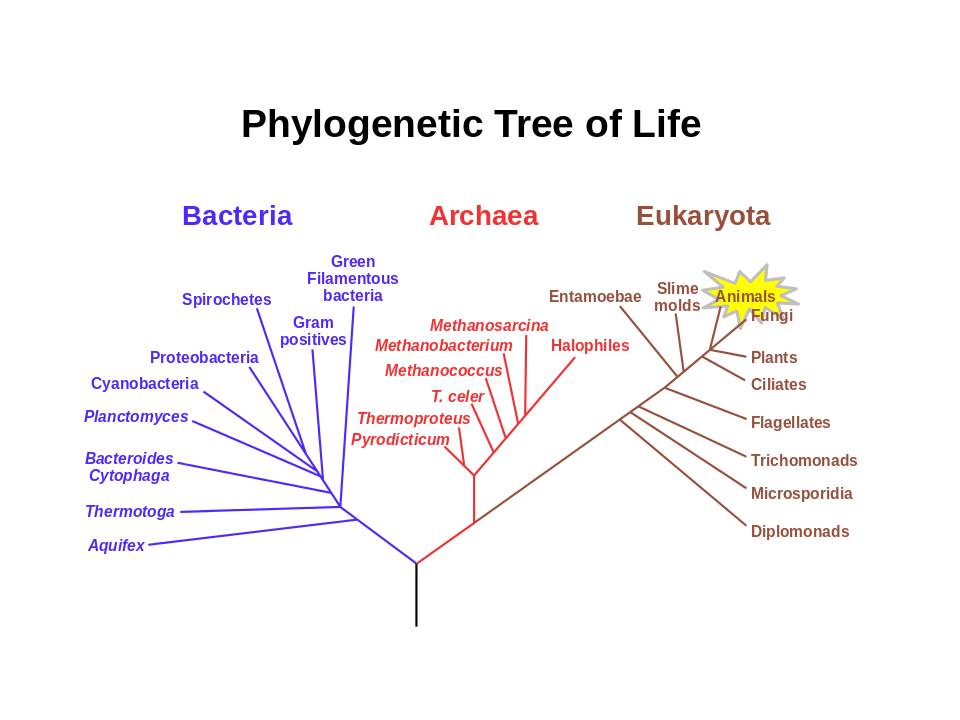
Image obtained from Wikipedia.
Kingdom: Animalia (or Metazoa)
Members of this kingdom are multicellular, eukaryotic organisms. They are also heterotrophic and lack cell walls, which leads to more flexibility for motility. All animals, besides sponges, possess different tissues layers during embryonic development. Along with the Chordata, other members of this kingdom are Porifera, Cnidaria, Ctenophora, Platyhelminthes, Annelida, Mollusca, Nematoda, Arthropoda, and Echinodermata.
Phlyum: Chordata
At some point throughout their lifetime, members of the Chordata phylum possess 5 unique characteristics, which include a notochord, dorsal, tubular nerve chord, pharyngeal pouches, endostyle (precursor to the thyroid gland), and a postanal tail. It is important to remember that although all members possess these features, they may appear at different points within development or throughout the life cycle depending on the species. Organisms within this phylum also contain a coelom, complete digestive tract, segmentation, bilateral symmetry, and are triploblastic, meaning the embryos contain 3 types of tissue layers. Other chordates within this phylum include the sea squirt, Cephalochordata, and Vertebrata.
Sub-phylum: Vertebrata
Vertebrates are animals that possess backbones, as well as having a high level of cephalization. Birds, mammals, reptiles, amphibians, and fish are all examples of chordates belonging to this sub-phylum.
Class: Reptilia
In addition to possessing backbones, organisms within the reptile class have skulls, brains and sensory, alimentary, excretory, and reproductive organs. Eastern tiger snakes respire via lungs, have keratinized epidermal scales, and are cold-blooded animals, meaning their body temperature depends on that of the environment it is in. These scales specifically allow for protection, as well as preventing water loss. Many organisms of this class are tetrapod, which indicated they possess 4 legs, but as we see with some animals such as the snakes and legless lizards, this is not true for every reptile. Although some members are still utilizing water, this is the first group to become truly independent of water. The amniotic egg, which allowed for the movement away from water, is seen by many reptiles. In particular, Notechis scutatus is one of the exceptions of this class that do not lay amniotic eggs, but rather give live birth. Other members within this class are specific lizard, alligator, crocodile, and turtle species.
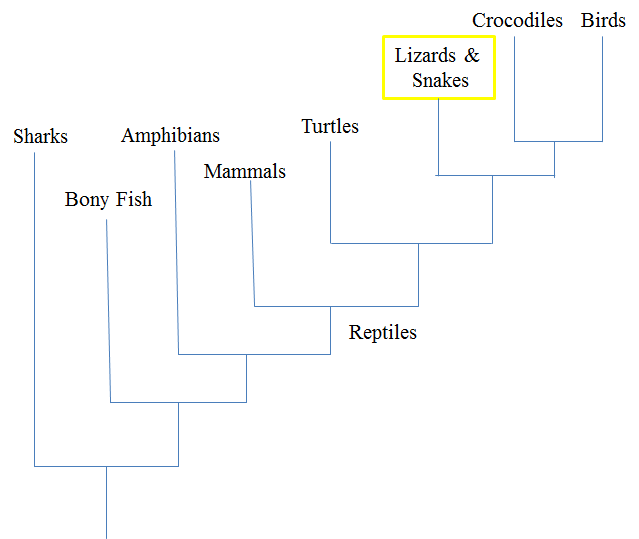
FIGURE: This is a modified tree from "Snakes in question: the Smithsonian Answer Book" , showing the morphological evolutionary relationships of living vertebrates.
Order: Squamata
Did you know? Squamata came from the Latin word meaning “scaly”?
The Squamata order includes all snakes and lizards. Characteristics shared by organisms within this group include periodically shedding the outer epidermal layer and possessing moveable jaws. The mobility and strength of the jaw allows for a powerful bite and being able to swallow large animals. Other examples of different snake species include Crotalus horridus and Nerodia sipedon. Another example of a specific lizard species is Pogona vitticeps.
Family: Elapidae
Members of the Elapidae family include the Cobras, Coral snakes, and Australian snakes. Elapids contain fangs located in the front of the upper jaw. They also possess a neurotoxic venom, causing effects on the nervous system of the prey items.
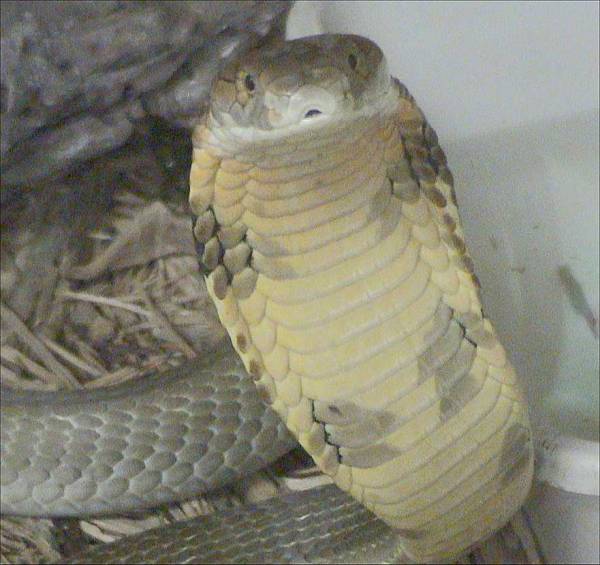
Image obtained from Wikipedia.
Genus: Notechis
Notechis, meaning “tiger snake”, characterizes members of this group possessing tiger-like stripes, although not every species possesses them. Another characteristic shared by members of this genus is a large, semi-square-shaped frontal shield scale. Tiger snakes give live birth to large amounts of young and can commonly be found throughout Australia and surrounding islands. Species within this genus are also diurnal and ovoviviparous.
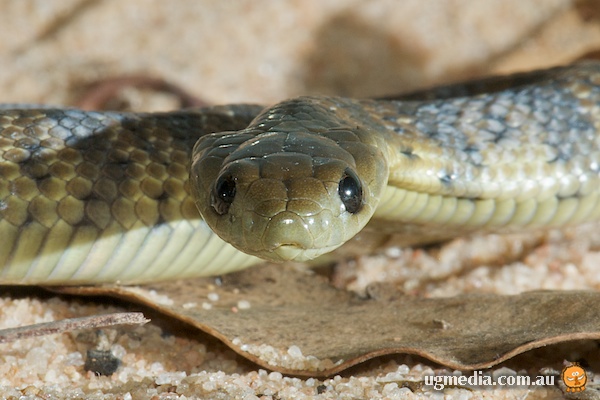
Photograph courtesy of Stewart MacDonald.
Species: Notechis scutatus
This specific species is highly variable and ranges in color, but possesses yellow-brown banding. Notechis scutatus are proteroglyphous, meaning that they possess fangs at the front of their upper jaw that excrete venom. The poison is produced by the venom gland and is transferred into the top of the fang. From there, the poison is then transferred through a tube within the tooth where it enters the wound upon biting. It is possible to find members of this species to not contain any stripes at all. Although not always reliable, this specific coloring and banding characteristic separates it from other species within the same genus. For example, Notechis ater, or commonly known as the black tiger snake, possesses a uniformly black color.
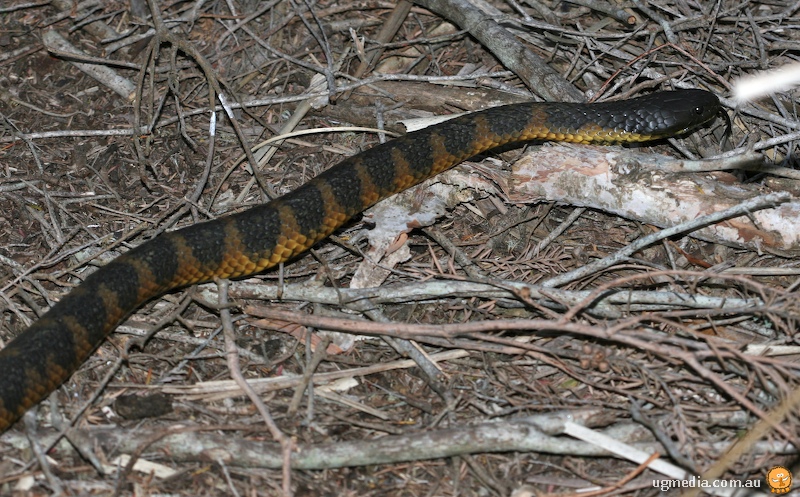
Source of this picture: Stewart MacDonald.
Not blown away yet? Head to the home of Notechis scutatus or back to the home page of this site.